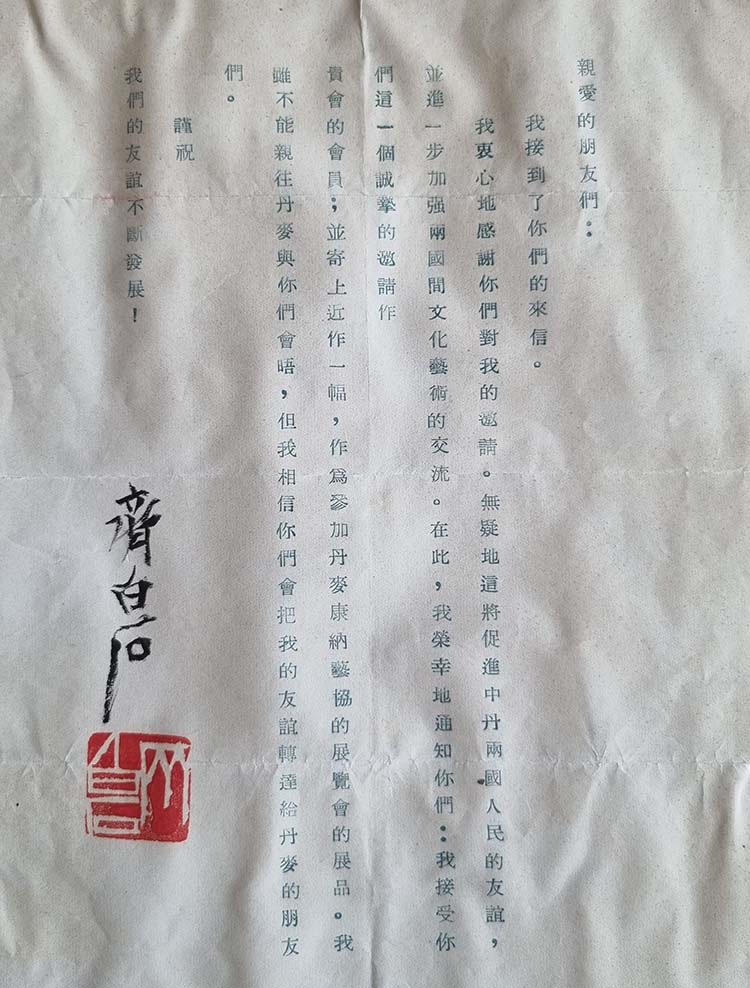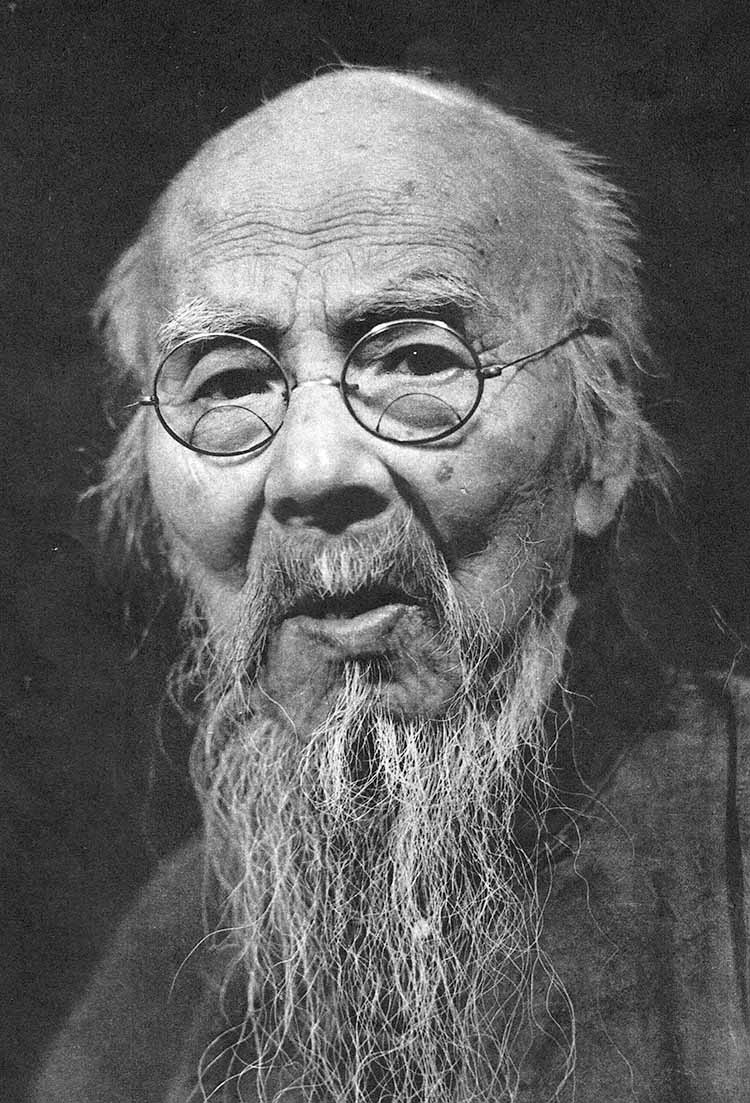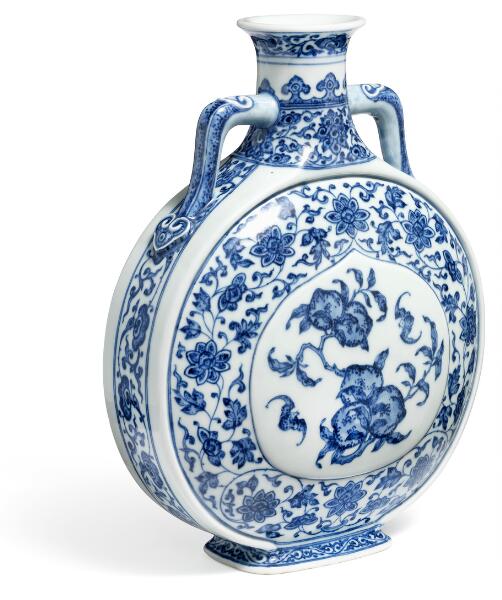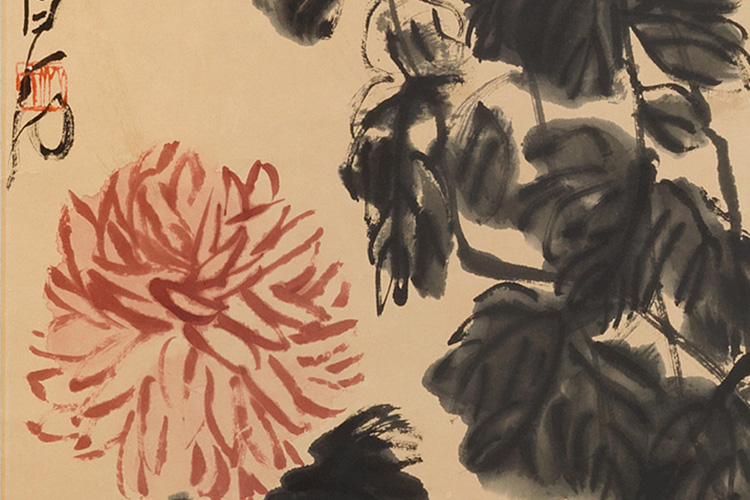The people’s artist Qi Baishi and Corner
Originally a woodcarver, Qi Baishi turned to studying painting at the age of 27. Though he considered his poetry his greatest legacy, it was his vivid portrayals of nature that brought him acclaim. And at the age of 89, he became a member of Corner and celebrated as “the people’s artist”. “Chrysanthemums”, the work gifted to Corner by the Chinese artist Qi Baishi in 1953, is now set to go under the hammer at our Live Auction.
Members of the Corner Association held an almost profound reverence for China, both ancient and modern. They admired how its artistic excellence had endured for millennia, built upon unbroken traditions of craftsmanship and labour, poetry and a simple philosophical approach to life and the universe. In the early years of the People’s Republic of China, the Corner exhibition therefore invited both Chinese painters and an entire school of Chinese graphic artists – all closely associated with the new communist state – to exhibit their work. Among them was the old master Qi Baishi (1864–1957), who, as Corner group co-founder Karl Bovin noted, was internationally acclaimed for depicting “life on paper”.
“Although Baishi’s works are well-known to our auction audience, this is our first opportunity to present an original piece by the artist. The early 1950s saw close ties develop between Baishi and Corner’s artistic community. But Baishi’s influence extended further, and over the years we’ve sold numerous bound volumes featuring woodcuts by both him and other contemporary Chinese artists. I assume these were acquired in connection with Corner’s early exhibitions. This first-time offering of “Chrysanthemums” on the art market offers its future owner both an artwork and a piece of cultural history – the special bond between Baishi and Corner.”
Alexandra NilssonSpecialist in older, Asian and Islamic decorative art at Bruun Rasmussen
Life on paperQi Baishi was a painter, calligrapher, poet, printmaker, woodcarver and seal carver. Self-taught, he journeyed through China’s provinces studying the classical painters of the Ming and Tang dynasties. He made a living painting traditional ancestral portraits of landed gentry. His drawing skills were equally remarkable, sensitively capturing flora and fauna with such vivid simplicity that, it is said, he even strove to reproduce the internal movements of shrimp on paper. During the long period of rebellion, revolutionary upheavals and world wars, he maintained a steady, peaceful devotion to his art – both poetry and painting. Though Qi Baishi himself considered his paintings of lesser importance, it was through them that he achieved worldwide fame. He could depict willow leaves swaying in the wind and dragonfly wings quivering in the sun. Qi Baishi’s brushstrokes possessed the simplicity of the ancient Chinese masters, while his calligraphy breathed new life into traditional techniques. Corner and the East: When Corner opened its first exhibition in 1932, it immediately achieved both critical and public acclaim, showcasing 18 artists working across diverse media: painting, sculpture, drawing, prints, appliqué, weaving, ceramics and design. At the heart of the group were artists Karl Bovin, Kaj Estrup and Lauritz Hartz. In their mission to make art accessible to a wider audience, the group went as far as to hand out free tickets to the exhibition and concerts to people in unemployment lines. Corner made art acquisition more accessible by offering instalment payment options. The Danish artists’ association rapidly developed an international profile, becoming renowned for its broad artistic scope that encompassed puppet theatre, stained glass, classical music and documentaries. Corner actively sought to showcase foreign artists in Denmark, particularly those from communist countries. Beginning with early Chinese exhibitions, the programme evolved to include Soviet artists, and ultimately led to Corner artists exhibiting their work in both Beijing and Leningrad. |
Qi Baishi – member of Corner
In 1951, Corner presented a comprehensive exhibition of Chinese art, showing Danish audiences the continuity between classical and contemporary Chinese art, particularly highlighting the deep respect of modern artists for their artistic traditions. This was the first time contemporary Chinese art was exhibited in Western Europe, Among the exhibited works were two pieces by Qi Baishi. The elderly Chinese artist attracted considerable attention. Corner decided to invite Qi Baishi to become a member of the association. Hans Scherfig welcomed him. As a gesture of thanks, Qi Baishi presented Corner with the scroll painting “Chrysanthemums”, which was first exhibited at Corner in 1954 and again in 1958, alongside 30 other works by him in a memorial exhibition following his death. Qi Baishi became a source of inspiration for several of the Corner painters, including Lauritz Hartz, Karl Bovin and Kaj Estrup.

|
World fame
Qi Baishi’s motifs are typically Chinese flora and fauna, cicadas, grasshoppers, dragonflies, crabs, frogs, poultry, mountains, rivers, waterfalls and flowers. Under the new Chinese regime, he became president of the Chinese Artists’ Association and was designated “People’s Artist” by the Chinese Ministry of Culture in 1953. In 1955, he was awarded honorary membership of the art academy in GDR. During his lifetime, Qi Baishi exhibited both in Denmark and at the Biennale in Venice. After his death, a retrospective of his work – the first Danish art exhibition in China – was held in The Forbidden City in 1961. In 2008, a crater on Mercury was named after the great, old Chinese artist, and his iconic works continue to triumph at major solo exhibitions, most recently at Kyoto National Museum (2019), The Bowers Museum (USA, 2015), Honolulu Museum of Art (2014) and at Sophienholm (2007).

|

|
The art of the old master
Qi Baishi, the old master, created art that is not only world-famous and highly coveted, but speaks to human emotions transcending time. Qi Baishi’s global fame endures, making him one of the most reproduced modern Chinese artists today. His art bridges ancient tradition and modernity.

For further information, please contact
|
|
Alexandra NilssonAlexandra NilssonSpecialist / Decorative Art & Classic Interior / København |



